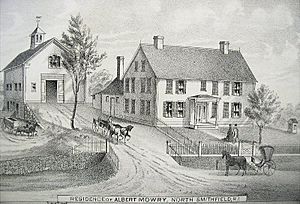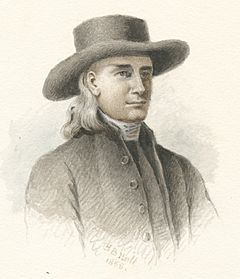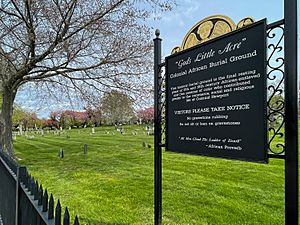History of Rhode Island facts for kids

The history of Rhode Island tells the story of the Colony of Rhode Island and Providence Plantations and the state of Rhode Island. It covers everything from before Europeans arrived until today.
Contents
Early Times: Before European Settlers
Before Europeans came, Native American tribes lived in most of the area that is now Rhode Island. These included the Wampanoag, Narragansett, and Niantic tribes. Many Native Americans died from diseases, possibly brought by European explorers. They also faced conflicts with other tribes. The Narragansett language eventually disappeared, but some of it was saved in a book by Roger Williams called A Key into the Languages of America (1643).
Rhode Island as a Colony: 1636–1776
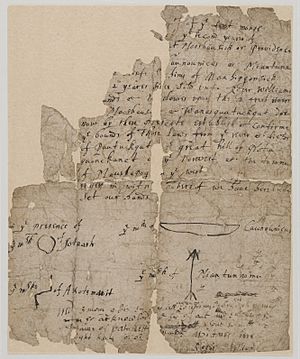
In 1636, Roger Williams started a settlement on land given to him by the Narragansett tribe. He had been forced to leave the Massachusetts Bay Colony because of his religious beliefs. He named his new home "Providence Plantations" and made it a place where people could have religious freedom.
In 1638, Anne Hutchinson, William Coddington, John Clarke, and others who disagreed with the Massachusetts Bay Colony settled on Rhode Island. They started a town called Portsmouth. Later, disagreements led to the southern part of the island becoming a separate town called Newport.
Another settler, Samuel Gorton, bought Native American land in Shawomet in 1642. This caused a dispute with the Massachusetts Bay Colony. In 1644, Providence, Portsmouth, and Newport joined together to protect their independence. They formed the Colony of Rhode Island and Providence Plantations. In 1648, the King of England gave Gorton a special paper for his settlement, which he named Warwick. These four settlements finally became one colony under the Royal Charter of 1663. Some people at the time called it "Rogue's Island" because it welcomed people who had been kicked out of Massachusetts Bay.
In 1686, King James II ordered Rhode Island to join the Dominion of New England, which was led by Governor Edmund Andros. This meant Rhode Island's charter was put on hold. However, Rhode Island managed to keep its charter until Andros was removed and the Dominion ended. After the Glorious Revolution of 1688, William of Orange became King. Rhode Island's independent government started again under its 1663 charter. This charter was used as the state's constitution until 1842.
In 1693, King William III and Mary II expanded Rhode Island's territory. This caused some arguments over land with the Plymouth Colony.
Colonial Relations with Native Americans
At first, relations between the New England settlers and Native American tribes were mostly peaceful. The main tribes near Rhode Island were the Wampanoags, Pequots, Narragansetts, and Nipmucks. Squanto, a Wampanoag, helped the Pilgrims in Plymouth Colony learn how to survive.
Roger Williams was respected by other colonists for keeping the powerful Narragansetts friendly. In 1637, the Narragansetts even joined Rhode Island in an alliance during the Pequot War. However, this peace did not last. The most difficult event in 17th-century Rhode Island was King Philip's War (1675–76). Metacomet, known as King Philip by the settlers, was the chief of the Wampanoags. He led attacks around Narragansett Bay, even though Rhode Island tried to stay neutral. These attacks spread across New England.
On December 19, 1675, soldiers from Massachusetts, Connecticut, and Plymouth attacked and destroyed a fortified Narragansett village in the Great Swamp Fight in southern Rhode Island. The Narragansetts also attacked and burned several Rhode Island settlements, including Providence. They allowed the people to leave first. In one of the last actions of the war, Captain Benjamin Church and his troops from Connecticut found and killed King Philip at Mount Hope (Rhode Island).
Revolutionary Era: 1775–1790
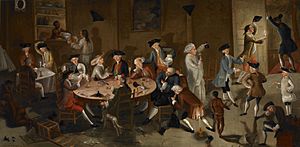
Rhode Island was the first colony in America to declare independence on May 4, 1776. This was two months before the United States Declaration of Independence. Rhode Islanders had already attacked the British warship HMS Gaspee in 1772. This was one of the first acts of war leading to the American Revolution.
British naval forces controlled Narragansett Bay for much of the Revolutionary War. They often raided the islands and mainland. British forces occupied Newport from 1777 to 1778, pushing the Colonial forces to Bristol.
Battle of Rhode Island
The Battle of Rhode Island happened in the summer of 1778. It was an attempt to force the British out of Narragansett Bay, but it was not successful. However, few Colonial soldiers were lost. The Marquis de Lafayette called it the "best fought" action of the war. The British eventually left Newport to focus their forces in New York.
French forces led by Rochambeau landed in Newport in 1780. Newport became the base for French forces in the United States for the rest of the war. The French soldiers behaved so well that the Rhode Island General Assembly removed an old law that banned Catholics from living in Rhode Island. The first Catholic mass in Rhode Island was held in Newport during this time.
Many people in rural Rhode Island were against the new United States Constitution. The anti-federalist Country Party controlled the General Assembly from 1786 to 1790. In 1788, General William West led about 1,000 armed troops to Providence. They wanted to stop a celebration of nine states having approved the Constitution. A civil war was almost started, but a compromise was reached. Rhode Island was the last of the 13 states to approve the United States Constitution (May 29, 1790). It only did so after being threatened with taxes on its exports, as if it were a foreign country.
Slavery in Rhode Island
In 1652, Rhode Island passed the first law in the Thirteen Colonies banning slavery. However, this law was not enforced by the end of the 1600s. In 1703, a new law effectively overturned it.
By 1774, about 6.3 percent of Rhode Island's population was enslaved. This was almost twice as high as any other New England colony. In the late 1700s, some Rhode Island merchant families became very involved in the triangle trade. This trade involved distilling rum from molasses, trading the rum for enslaved people in Africa, and then trading the enslaved people in the West Indies for more molasses. James and John DeWolf of Bristol were among the largest slave traders in Rhode Island. After the Revolution, Rhode Island merchants controlled a large part of the American trade of enslaved African people.
Stephen Hopkins, who signed the Declaration of Independence and owned enslaved people, introduced a bill in 1774. This bill stopped the import of enslaved people into the colony. It was one of the first anti-slavery laws in the United States. In February 1784, Rhode Island passed a law for gradual emancipation. This meant that children born to enslaved parents after March 1 would become apprentices. Girls would be free at 18, and boys at 21. By 1840, the census showed only five formerly enslaved Africans in Rhode Island. However, the international slave trade continued even with these laws. By the mid-1800s, many Rhode Islanders, especially Quakers like Moses Brown, were active in the movement to end slavery.
Slave Trade in Newport
The first recorded slave ship, the "Sea Flower," arrived in Newport in 1696. It carried 47 captives, and 14 of them were sold in Newport.
By the early 1700s, Newport was a major center in the triangular slave trade. About half of the slave ship voyages in the colonies started from Newport. Newport had both a large free Black population and a large enslaved population. Free and enslaved Black people worked in many industries, from making sails to grinding chocolate. The Free African Union Society, America's first African benevolent society, was founded in Newport in 1780.
"God's Little Acre," an African American burial ground in Newport, has gravestones dating back to the 1700s.
Rhode Island's Constitution finally freed all enslaved people in 1843. Section 4 stated: "Slavery shall not be permitted in this state."
Industrial Revolution

In 1790, an English immigrant named Samuel Slater started the first textile mill in the United States in Pawtucket, Rhode Island (Slater Mill). He became known as the father of the American Industrial Revolution. During the 1800s, Rhode Island became one of the most industrialized states in America, with many textile factories. The state also had important machine tool, silverware, and costume jewelry industries.
The Industrial Revolution caused many workers to move to cities. It also attracted many immigrants from Ireland. A group of men who did not own land grew, and they were not allowed to vote under Rhode Island law. By 1829, 60 percent of the state's men could not vote. All attempts to change this failed because rural areas controlled the political system. In 1842, Thomas Dorr wrote a new constitution and tried to get people to vote for it. However, Governor Samuel Ward King was against it, leading to the Dorr Rebellion. The rebellion did not get much support and failed, and Dorr went to prison. But the conservatives eventually allowed most American-born men to vote. The new Constitution of Rhode Island took effect in May 1843.
Civil War
During the American Civil War, Rhode Island sent 25,236 soldiers to the Union armies. Of these, 1,685 died. Rhode Island used its factories to provide the Union Army with supplies needed to win the war. Rhode Island's continued growth led to better public transportation and improved health programs. In 1866, Rhode Island ended racial segregation throughout the state. Governor William Sprague IV fought at the First Battle of Bull Run while he was still governor. Rhode Island general Ambrose Burnside became one of the war's major heroes.
The Gilded Age
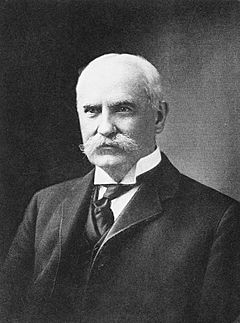
The fifty years after the Civil War were a time of great wealth and growth. Rhode Island was a key place during the Gilded Age. Many of the country's richest industrialists, sometimes called robber barons, had homes or summer homes there. This was a time of huge growth in textile mills and factories. Many immigrants came to fill these jobs. The state's population grew, and cities became larger.
In Newport, New York's wealthiest people built grand mansions for their summer homes. In cities like Providence, Pawtucket, and Woonsocket, thousands of French-Canadian, Italian, Irish, and Portuguese immigrants arrived to work in the mills. In response, the Know Nothing party tried to keep these newcomers from having political power. The 1843 constitution prevented poor men without land from voting. It also made sure that cities had less power in the state legislature than rural towns.
Around the start of the 1900s, Rhode Island had a very strong economy, which led to more immigration. During World War I, Rhode Island sent 28,817 troops, and 612 of them died. After the war, the state was hit hard by the Spanish Influenza.
Racial Hostility
In the 1920s and 1930s, the Ku Klux Klan grew in rural Rhode Island. This was mostly among white people born in America, reacting to the large number of immigrants moving to the state. The Klan is believed to be responsible for burning the Watchman Industrial School in Scituate, Rhode Island, which was a school for African American children.
Since 1929
In 1935, Governor Theodore Francis Green and Democrats in the state House and Senate took control from the Republicans. This event is called the "Bloodless Revolution." Since then, the Rhode Island Democratic Party has mostly controlled state politics. The Speaker of the House has always been a Democrat and is one of the most powerful people in the government.
The Democratic Party in Rhode Island is made up of labor unions, working-class immigrants, thinkers, college students, and the growing middle class. The Republican Party has been stronger in rural and suburban parts of the state. They have sometimes nominated candidates who criticize the state's high taxes.
The state income tax was first put in place in 1971 as a temporary measure. Before 1971, there was no income tax. But the temporary tax soon became permanent. The total tax burden in Rhode Island is still among the five highest in the United States.
A new Constitution of Rhode Island was approved in 1986 and started on January 20, 1987.
Rhode Islanders have strongly supported and re-elected Democrats. As of 2020[update], Rhode Island has mostly Democratic legislatures. Both U.S. Senators and Congressmen, and all statewide offices, are held by Democrats. The state has voted for Democratic presidential candidates in every election since 1988.
Population Growth
| Historical population | |||
|---|---|---|---|
| Census | Pop. | %± | |
| 1790 | 68,825 | — | |
| 1800 | 69,122 | 0.4% | |
| 1810 | 76,931 | 11.3% | |
| 1820 | 83,059 | 8.0% | |
| 1830 | 97,199 | 17.0% | |
| 1840 | 108,830 | 12.0% | |
| 1850 | 147,545 | 35.6% | |
| 1860 | 174,620 | 18.4% | |
| 1870 | 217,353 | 24.5% | |
| 1880 | 276,531 | 27.2% | |
| 1890 | 345,506 | 24.9% | |
| 1900 | 428,556 | 24.0% | |
| 1910 | 542,610 | 26.6% | |
| 1920 | 604,397 | 11.4% | |
| 1930 | 687,497 | 13.7% | |
| 1940 | 713,346 | 3.8% | |
| 1950 | 791,896 | 11.0% | |
| 1960 | 859,488 | 8.5% | |
| 1970 | 946,725 | 10.1% | |
| 1980 | 947,154 | 0.0% | |
| 1990 | 1,003,464 | 5.9% | |
| 2000 | 1,048,319 | 4.5% | |
| 2010 | 1,052,567 | 0.4% | |
| 2020 | 1,097,379 | 4.3% | |
| Source: 1910–2020 | |||
See Also
- Ratification of the United States Constitution by Rhode Island
- History of New England
- Colony of Rhode Island and Providence Plantations
- Women's suffrage in Rhode Island
- Thirteen Colonies
- Timeline of Newport, Rhode Island
- Timeline of Providence, Rhode Island






